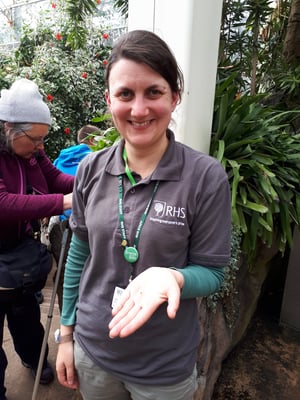Assessing slug diversity and how the public can help to identify species
23 September 2024 | By: Newcastle University | 2 min read
We’ve been asking volunteers to monitor slug activity in their gardens to help improve national advice on managing these molluscs.
Find out why slugs – and our volunteers - matter in this unique, citizen scientist study.
Contents:
- Slug species in the UK
- Assessing slug species diversity
- What is citizen science?
- Snail mail
- Biological recording
- The results
Slug species in the UK
There are over 40 species of slugs in the UK. While 20% of these can cause problems to gardeners and growers, most of the UK’s slugs have important roles within their various natural habitats and help to sustain a balanced ecosystem.
It’s been over 80 years since the last major study of slug diversity and activity in gardens was carried out by entomologists Barnes and Weil.
Assessing slug species diversity
The primary purpose of the Slugs Count project - undertaken by Newcastle University, The Royal Horticultural Society (RHS) and the UK Centre for Ecology and Hydrology - was to measure the diversity of slugs in our gardens. Helping to provide gardeners updated national advice in spotting which slugs are a help or hinderance to their flora efforts.
This Newcastle University PhD project, led by Dr Imogen Cavadino, said: “Slugs are often considered a gardener’s greatest foe. But, only nine are major plant pests.
“Most prefer to eat rotting material and could be considered a gardener’s friend, vital to a gardens ecosystem. This research set out to challenge the misconceptions about this creature.”
The project also investigated how much we can rely on volunteers when collating reliable biodiversity intelligence.
What is citizen science?
Citizen science is research carried out with participation from the public or nonprofessional researchers.
Citizen science is used in a wide range of areas of study including ecology, biology and conservation, health and medical research, astronomy, media and communications and information science. Citizen science is sometimes referred to as community science, crowd science, crowd-sourced science, civic science, or participatory monitoring.
A huge benefit of citizen science is that it can achieve a much greater spatial coverage over a shorter period of time than studies conducted solely by professional scientists.
The success of citizen science projects relies upon:
- a good project design
- strong application pool
- with robust volunteer training and testing
Issues during such projects can include:
- a volunteer’s personal bias from previous experience and attitudes
- retention of the volunteer
Dr Cavadino, said: “Our study shows that training and support can help people stay engaged with a project and produce useful results, even with a demanding procedure and tricky to identify study group such as slugs.”
Snail mail
Sixty participants were selected for this project, from over 2,700 applications.
The research team asked participants to:
- carry out a 30-minute, torchlit search of their gardens once every four weeks for a year
- collect any slugs they found, attempt to identify them and send them in the post to experts at the RHS to confirm their taxonomy
Dr Cavadino said: “I’ve been sent over 20,000 slugs in the post during the project, helping support our volunteers’ to identify the slugs, while also assessing the diversity and gathering data about this gastropod, in UK gardens.”
Slug Count chose a structured, repeat, sampling design using a standardised method.
Volunteers were provided with training on slug identification, and an identification guide.
The research team also gave ongoing support to help reinforce training and improve data accuracy.

Photograph of Dr Cavadino working at the RHS. Photo: RHS, Hayley Jones
Biological recording
The scientists analysed the differences between the identifications made by project participants and the experienced slug researcher, to give a unique insight in to how often mistakes in identification were made.
Participants did overestimate slug abundance and species richness.
The results
In this study, a total of 20,374 slugs were collected by participants and identified to species by the volunteers, representing up to 34 species.
Their results show that project participants correctly identified slugs at the start of the project 47 – 56% of the time, But this improved to 59 – 70% by the end of the project.
The Slugs Count project has demonstrated that citizen science programmes involving identification can successfully generate large amounts of good quality data. While also being highly enjoyable to those that take part.
It also highlights the importance of expert involvement and participant support to ensure data accuracy and sustained engagement.
Dr Cavadino, said: “Citizen science provided an effective approach to assess slug diversity across widespread geographic locations throughout a full year of sampling.
“Despite the complexity of the Slugs Count protocol, there was a high level of engagement throughout the study, and the resulting high-quality dataset contributes hugely to our understanding of the current status of slugs in British gardens.”
You might also like
- read the research paper: Cavadino, I., Port, G., Mill, A., Clover, G., Roy, H. E., & Jones, H. (2024). Slugs Count: Assessing citizen scientist engagement and development, and the accuracy of their identifications. People and Nature, 00, 1–16. https://doi.org/10.1002/pan3.10677
- find out about the UK Centre for Ecology and Hydrology
- discover The Royal Horticultural Society
